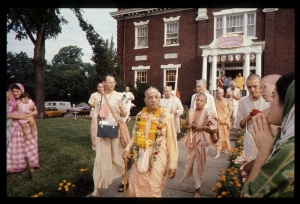SB 7.15.42

A.C. Bhaktivedanta Swami Prabhupada
TEXT 42
- akṣaṁ daśa-prāṇam adharma-dharmau
- cakre 'bhimānaṁ rathinaṁ ca jīvam
- dhanur hi tasya praṇavaṁ paṭhanti
- śaraṁ tu jīvaṁ param eva lakṣyam
SYNONYMS
akṣam — the spokes (on the chariot wheel); daśa — ten; prāṇam — the ten kinds of air flowing within the body; adharma — irreligion; dharmau — religion (two sides of the wheel, up and down); cakre — in the wheel; abhimānam — false identification; rathinam — the charioteer or master of the body; ca — also; jīvam — the living entity; dhanuḥ — the bow; hi — indeed; tasya — his; praṇavam — the Vedic mantra oṁkāra; paṭhanti — it is said; śaram — an arrow; tu — but; jīvam — the living entity; param — the Supreme Lord; eva — indeed; lakṣyam — the target.
TRANSLATION
The ten kinds of air acting within the body are compared to the spokes of the chariot's wheels, and the top and bottom of the wheel itself are called religion and irreligion. The living entity in the bodily concept of life is the owner of the chariot. The Vedic mantra praṇava is the bow, the pure living entity himself is the arrow, and the target is the Supreme Being.
PURPORT
Ten kinds of life air always flow within the material body. They are called prāṇa, apāna, samāna, vyāna, udāna, nāga, kūrma, kṛkala, devadatta and dhanañjaya. They are compared here to the spokes of the chariot's wheels. The life air is the energy for all of a living being's activities, which are sometimes religious and sometimes irreligious. Thus religion and irreligion are said to be the upper and lower portions of the chariot's wheels. When the living entity decides to go back home, back to Godhead, his target is Lord Viṣṇu, the Supreme Personality of Godhead. In the conditioned state of life, one does not understand that the goal of life is the Supreme Lord. Na te viduḥ svārtha-gatiṁ hi viṣṇuṁ durāśayā ye bahir-artha-māninaḥ (SB 7.5.31). The living entity tries to be happy within this material world, not understanding the target of his life. When he is purified, however, he gives up his bodily conception of life and his false identity as belonging to a certain community, a certain nation, a certain society, a certain family and so on (sarvopādhi-vinirmuktaṁ tat-paratvena nirmalam (CC Madhya 19.170)). Then he takes the arrow of his purified life, and with the help of the bow — the transcendental chanting of praṇava, or the Hare Kṛṣṇa mantra — he throws himself toward the Supreme Personality of Godhead.
Śrīla Viśvanātha Cakravartī Ṭhākura has commented that because the words "bow" and "arrow" are used in this verse, one might argue that the Supreme Personality of Godhead and the living entity have become enemies. However, although the Supreme Personality of Godhead may become the so-called enemy of the living being, this is His chivalrous pleasure. For example, the Lord fought with Bhīṣma, and when Bhīṣma pierced the Lord's body on the Battlefield of Kurukṣetra, this was a kind of humor or relationship, of which there are twelve. When the conditioned soul tries to reach the Lord by hurling an arrow at Him, the Lord takes pleasure, and the living entity gains the profit of going back home, back to Godhead. Another example given in this regard is that Arjuna, as a result of piercing the ādhāra-mīna, or the fish within the cakra, achieved the valuable gain of Draupadī. Similarly, if with the arrow of chanting the holy name of the Lord one pierces Lord Viṣṇu's lotus feet, by dint of performing this heroic activity of devotional service one receives the benefit of returning home, back to Godhead.